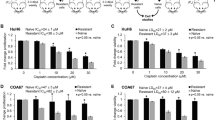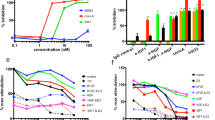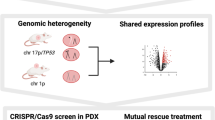Abstract
The cyclolignan PPP was recently demonstrated to inhibit the activity of insulin-like growth factor-1 receptor (IGF-1R), without affecting the highly homologous insulin receptor. In addition, PPP caused complete regression of xenografts derived from various types of cancer. These data highlight the use of this compound in cancer treatment. However, a general concern with antitumor agents is development of resistance. In light of this problem, we aimed to investigate whether malignant cells may develop serious resistance to PPP. After trying to select 10 malignant cell lines, with documented IGF-1R expression and apoptotic responsiveness to PPP treatment (IC50s less than 0.1 μ M), only two survived an 80-week selection but could only tolerate maximal PPP doses of 0.2 and 0.5 μ M, respectively. Any further increase in the PPP dose resulted in massive cell death. These two cell lines were demonstrated not to acquire any essential alteration in responsiveness to PPP regarding IGF-1-induced IGF-1R phosphorylation. Neither did they exhibit any increase in expression of the multidrug resistance proteins MDR1 or MRP1. Consistently, they did not exhibit decreased sensitivity to conventional cytostatic drugs. Rather, the sensitivity was increased. During the first half of the selection period, both cell lines responded with a temporary and moderate increase in IGF-1R expression, which appeared to be because of an increased transcription of the IGF-1R gene. This increase in IGF-1R might be necessary to make cells competent for further selection but only up to a PPP concentration of 0.2 and 0.5 μ M. In conclusion, malignant cells develop no or remarkably weak resistance to the IGF-1R inhibitor PPP.
This is a preview of subscription content, access via your institution
Access options
Subscribe to this journal
Receive 50 print issues and online access
$259.00 per year
only $5.18 per issue
Buy this article
- Purchase on Springer Link
- Instant access to full article PDF
Prices may be subject to local taxes which are calculated during checkout






Similar content being viewed by others
References
Adams TE, Epa VC, Garrett TP, Ward CW . (2000). Cell Mol Life Sci 57: 1050–1093.
Ahlen J, Wejde J, Brosjo O, von Rosen A, Weng WH, Girnita L et al. (2005). Clin Cancer Res 11: 206–216.
Alexia C, Fallot G, Lasfer M, Schweizer-Groyer G, Groyer A . (2004). Biochem Pharmacol 68: 1003–1015.
All-Ericsson C, Girnita L, Seregard S, Bartolazzi A, Jager MJ, Larsson O . (2002). Invest Ophthalmol Vis Sci 43: 1–8.
Baserga R . (1995). Cancer Res 55: 249–252.
Baserga R . (1999). Exp Cell Res 253: 1–6.
Baserga R . (2000). Oncogene 19: 5574–5581.
Baserga R, Hongo A, Rubini M, Prisco M, Valentinis B . (1997). Biochim Biophys Acta 1332: F105–F126.
Blum G, Gazit A, Levitzki A . (2000). Biochemistry 39: 15705–15712.
Blum G, Gazit A, Levitzki A . (2003). J Biol Chem 278: 40442–40454.
Bohula EA, Salisbury AJ, Sohail M, Playford MP, Riedemann J, Southern EM et al. (2003). J Biol Chem 278: 15991–15997.
Brodt P, Samani A, Navab R . (2000). Biochem Pharmacol 60: 1101–1107.
Buchardt O, Jensen RB, Hansen HF, Nielsen PE, Andersen D, Chinoin I . (1986). J Pharm Sci 75: 1076–1080.
Catrina SB, Lewitt M, Massambu C, Dricu A, Grunler J, Axelson M et al. (2005). Br J Cancer 92: 1467–1474.
Chen LL, Trent JC, Wu EF, Fuller GN, Ramdas L, Zhang W et al. (2004). Cancer Res 64: 5913–5919.
D'Ambrosio C, Ferber A, Resnicoff M, Baserga R . (1996). Cancer Res 56: 4013–4020.
De Meyts P, Whittaker J . (2002). Nat Rev Drug Discov 1: 769–783.
Favelyukis S, Till JH, Hubbard SR, Miller WT . (2001). Nat Struct Biol 8: 1058–1063.
Garcia-Echeverria C, Pearson MA, Marti A, Meyer T, Mestan J, Zimmermann J et al. (2004). Cancer Cell 5: 231–239.
Girnita A, All-Ericsson C, Economou M, Åström K, Axelson M, Seregard S et al. (2005a). Clin Cancer Res (in press).
Girnita A, Girnita L, Prete FD, Bartolazzi A, Larsson O, Axelson M . (2004). Cancer Res 64: 236–242.
Girnita L, Girnita A, Brodin B, Xie Y, Nilsson G, Dricu A et al. (2000a). Cancer Res 60: 5278–5283.
Girnita L, Girnita A, Larsson O . (2003). Proc Natl Acad Sci USA 100: 8247–8252.
Girnita L, Shenoy SK, Sehat B, Vasilcanu R, Girnita A, Lefkowitz RJ et al. (2005b). J Biol Chem 280: 24412–24419.
Girnita L, Wang M, Xie Y, Nilsson G, Dricu A, Wejde J et al. (2000b). Anticancer Drug Des 15: 67–72.
Goetsch L, Gonzalez A, Leger O, Beck A, Pauwels PJ, Haeuw JF et al. (2005). Int J Cancer 113: 316–328.
Gottesman MM, Fojo T, Bates SE . (2002). Nat Rev Cancer 2: 48–58.
Guo YS, Jin GF, Houston CW, Thompson JC, Townsend Jr CM . (1998). J Cell Physiol 175: 141–148.
Hernandez-Sanchez C, Werner H, Roberts Jr CT, Woo EJ, Hum DW, Rosenthal SM et al. (1997). J Biol Chem 272: 4663–4670.
Hirsch-Ernst KI, Ziemann C, Schmitz-Salue C, Foth H, Kahl GF . (1995). Biochem Biophys Res Commun 215: 179–185.
Jerome L, Shiry L, Leyland-Jones B . (2003). Endocr Relat Cancer 10: 561–578.
Jones HE, Goddard L, Gee JM, Hiscox S, Rubini M, Barrow D et al. (2004). Endocr Relat Cancer 11: 793–814.
Kanter-Lewensohn L, Girnita L, Girnita A, Dricu A, Olsson G, Leech L et al. (2000). Mol Cell Endocrinol 165: 131–137.
Laemmli UK . (1970). Nature 227: 680–685.
Larsson O, Girnita A, Girnita L . (2005). Br J Cancer 92: 2097–2101.
Le Roith D, Karas M, Yakar S, Qu BH, Wu Y, Blakesley VA . (1999). Isr Med Assoc J 1: 25–30.
LeRoith D, Werner H, Beitner-Johnson D, Roberts Jr CT . (1995). Endocr Rev 16: 143–163.
Longley DB, Johnston PG . (2005). J Pathol 205: 275–292.
Lu Y, Zi X, Pollak M . (2004). Int J Cancer 108: 334–341.
Menu E, Jernberg Wiklund H, Stromberg T, De Raeve H, Girnita L, Larsson O et al. (2005). Blood [Epub ahead of print].
Mitsiades CS, Mitsiades NS, McMullan CJ, Poulaki V, Shringarpure R, Akiyama M et al. (2004). Cancer Cell 5: 221–230.
Nagata Y, Lan KH, Zhou X, Tan M, Esteva FJ, Sahin AA et al. (2004). Cancer Cell 6: 117–127.
Nair PN, De Armond DT, Adamo ML, Strodel WE, Freeman JW . (2001). Oncogene 20: 8203–8214.
Navab R, Chevet E, Authier F, Di Guglielmo GM, Bergeron JJ, Brodt P . (2001). J Biol Chem 276: 13644–13649.
Parrizas M, Gazit A, Levitzki A, Wertheimer E, LeRoith D . (1997). Endocrinology 138: 1427–1433.
Pautsch A, Zoephel A, Ahorn H, Spevak W, Hauptmann R, Nar H . (2001). Structure (Camb) 9: 955–965.
Peggs K . (2004). Clin Exp Med 4: 1–9.
Reinmuth N, Liu W, Fan F, Jung YD, Ahmad SA, Stoeltzing O et al. (2002). Clin Cancer Res 8: 3259–3269.
Resnicoff M, Coppola D, Sell C, Rubin R, Ferrone S, Baserga R . (1994). Cancer Res 54: 4848–4850.
Rohlik QT, Adams D, Kull Jr FC, Jacobs S . (1987). Biochem Biophys Res Commun 149: 276–281.
Sachdev D, Li SL, Hartell JS, Fujita-Yamaguchi Y, Miller JS, Yee D . (2003). Cancer Res 63: 627–635.
Scotlandi K, Manara MC, Nicoletti G, Lollini PL, Lukas S, Benini S et al. (2005). Cancer Res 65: 3868–3876.
Stromberg T, Ekman S, Girnita L, Dimberg LY, Larsson O, Axelson M et al. (2005). Blood [Epub ahead of print].
Ulfarsson E, Karstrom A, Yin S, Girnita A, Vasilcanu D, Thoren M et al. (2005). Clin Cancer Res 11: 4674–4680.
Van Wyk JJ, Graves DC, Casella SJ, Jacobs S . (1985). J Clin Endocrinol Metab 61: 639–643.
Vasilcanu D, Girnita A, Girnita L, Vasilcanu R, Axelson M, Larsson O . (2004). Oncogene 23: 7854–7862.
Yang K, Lui WO, Xie Y, Zhang A, Skytting B, Mandahl N et al. (2002). Oncogene 21: 4181–4190.
Ye JJ, Liang SJ, Guo N, Li SL, Wu AM, Giannini S et al. (2003). Horm Metab Res 35: 836–842.
Yu H, Rohan T . (2000). J Natl Cancer Inst 92: 1472–1489.
Acknowledgements
This work was supported by Swedish Cancer Foundation, Swedish Research Council, Cancer Society in Stockholm, King Gustaf V's Jubilee Funds, Children Cancer Society, Stockholm County Council, Swedish Society for Medical Research, Biovitrum AB and Karolinska Institutet.
Author information
Authors and Affiliations
Corresponding author
Rights and permissions
About this article
Cite this article
Vasilcanu, D., Weng, WH., Girnita, A. et al. The insulin-like growth factor-1 receptor inhibitor PPP produces only very limited resistance in tumor cells exposed to long-term selection. Oncogene 25, 3186–3195 (2006). https://doi.org/10.1038/sj.onc.1209339
Received:
Revised:
Accepted:
Published:
Issue Date:
DOI: https://doi.org/10.1038/sj.onc.1209339
Keywords
This article is cited by
-
Oral administration of ellagic acid mitigates perioperative neurocognitive disorders, hippocampal oxidative stress, and neuroinflammation in aged mice by restoring IGF-1 signaling
Scientific Reports (2024)
-
IGF-1R is a molecular determinant for response to p53 reactivation therapy in conjunctival melanoma
Oncogene (2022)
-
Functional antagonism of β-arrestin isoforms balance IGF-1R expression and signalling with distinct cancer-related biological outcomes
Oncogene (2017)
-
Unbalancing p53/Mdm2/IGF-1R axis by Mdm2 activation restrains the IGF-1-dependent invasive phenotype of skin melanoma
Oncogene (2017)
-
Something old, something new and something borrowed: emerging paradigm of insulin-like growth factor type 1 receptor (IGF-1R) signaling regulation
Cellular and Molecular Life Sciences (2014)



